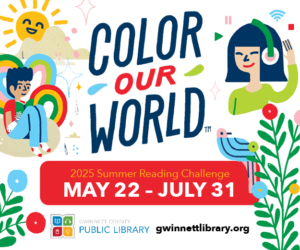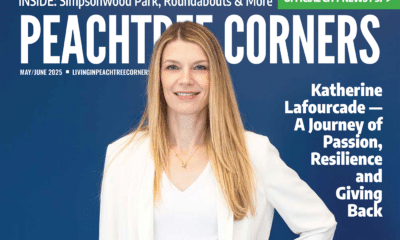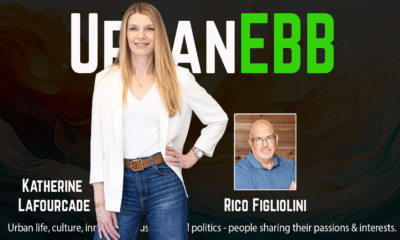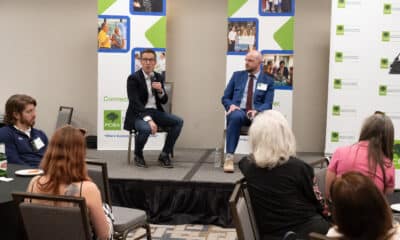Arts & Literature
Jennifer Keim Loves to Play & Explore the Beauty of Exotic Animals through Art
Published
2 years agoon
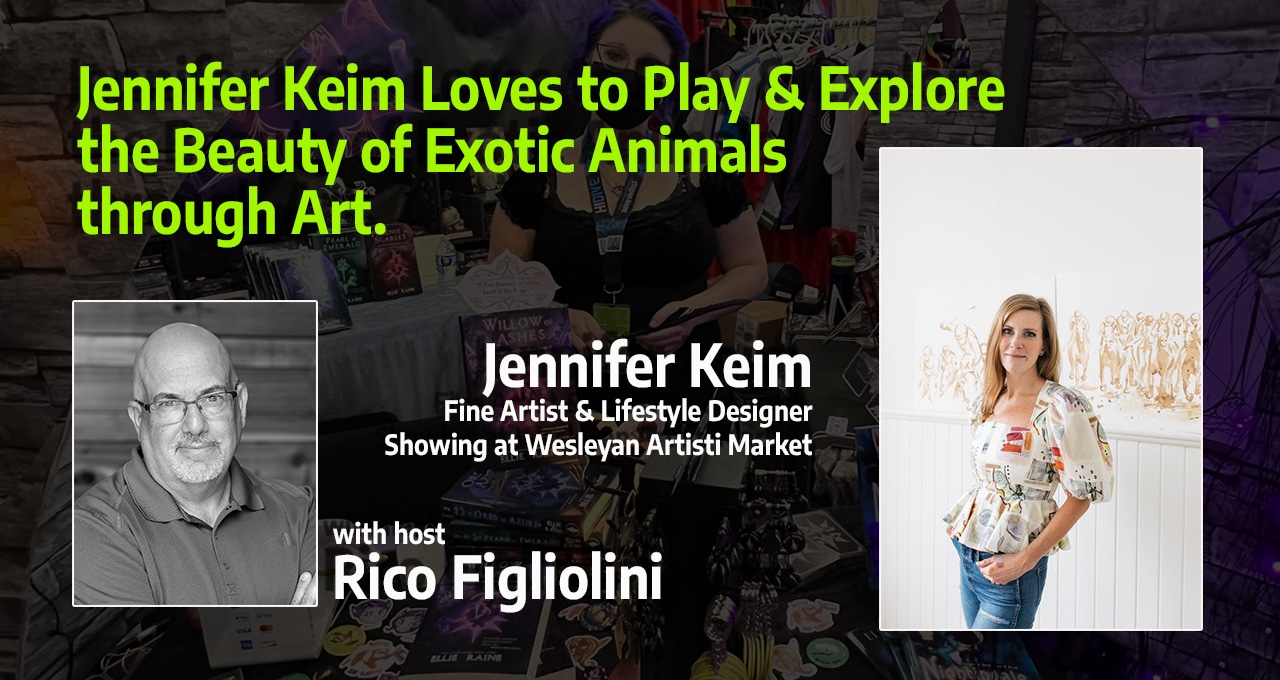
The Wesleyan Artist Market is back and celebrating its 25th year. On this special episode of Peachtree Corners Life, Rico Figliolini is joined by artist Jennifer Keim, one of the many artists featured at the Wesleyan Artist Market 2023. Jennifer shares her story, her inspiration, and a behind-the-scenes look into her creative process.
Resources:
Jennifer’s Website: https://www.jkeim.com
Jennifer’s Social Media: @JKeimStudio
Wesleyan Artist Market: artistmarket.wesleyanschool.org
“Already having an intrigue for the animals, wanting to be an exotic vet, and save the lions and tigers. I was already drawn to the massiveness. I just find them so beautiful and just so intriguing… I find that even if I’m in a rut, like what’s my next move? What’s my next series like? What do I want to do? Do I even want to do art anymore? In my moments of, oh, woe is me, I find that I just go back to the animals to help me break out of that rut.”
Jennifer Keim
Timestamp:
[00:00:30] – Intro
[00:02:20] – About Jennifer
[00:04:36] – Preferred Mediums
[00:12:53] – Using Wildlife and Travel Experiences
[00:16:55] – Creating Daily
[00:18:15] – Capturing a Moment
[00:20:13] – The Fly Guys Series
[00:24:39] – Textile Art
[00:28:11] – Jennifer’s Art at the Wesleyan Artist Market
[00:30:15] – Closing
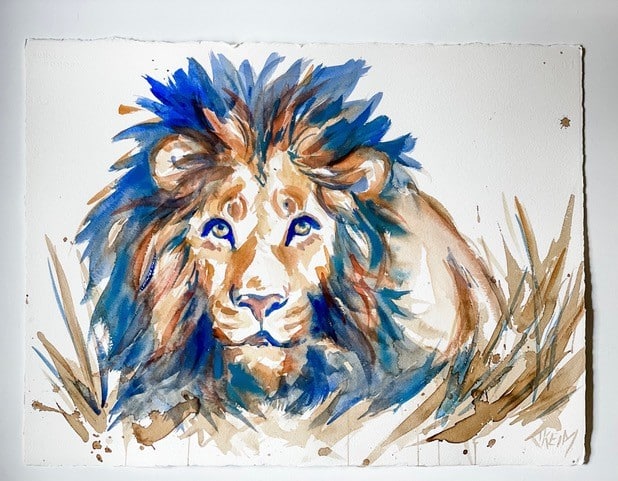
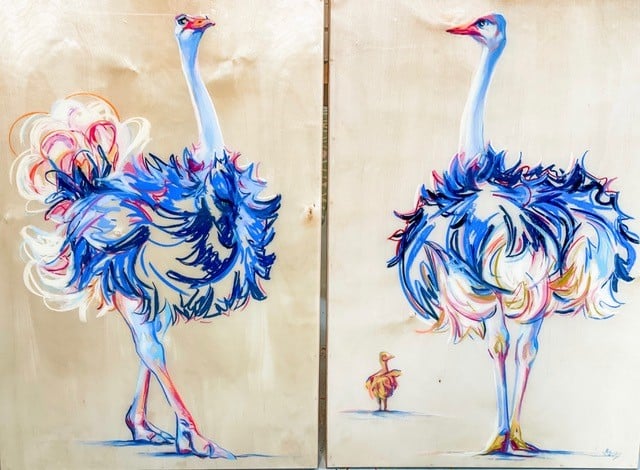
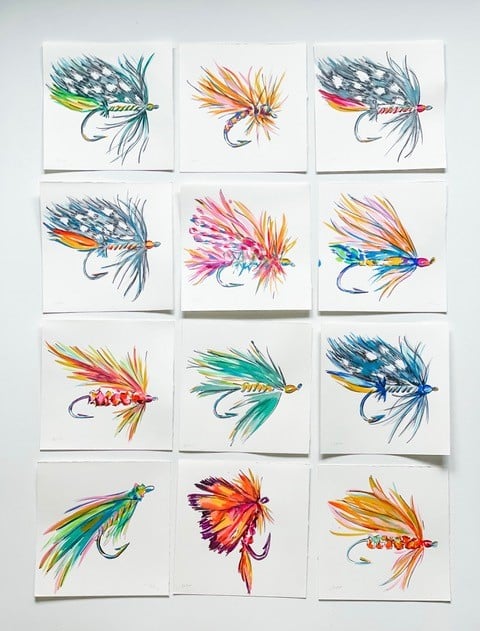
Podcast Transcript
[00:00:30] Rico: Hi everyone, this is Rico Figliolini, host of Peachtree Corners Life. I do want to introduce you to our show and our special guest today, all the way from Hawaii. Jennifer Keim. Hey Jennifer. Thanks for joining us.
[00:00:41] Jennifer: Hi. Happy to be here. Thank you for having me.
[00:00:45] Rico: Cool. I heard you were on the waters on the ocean before. Everything okay? Took some Go Pros?
[00:00:49] Jennifer: No, it’s just gorgeous.
[00:00:53] Rico: Sure.
[00:00:53] Jennifer: It is gorgeous. The whales are active. And I had the chance going yesterday to an out rigger where we paddle out and we’re just right there with the whales, so.
[00:01:04] Rico: That’s amazing. Yeah, and we’ll get into some of that. I mean, some of your artwork is animal related. So we’ll talk about that inspiration. But before we get there, let me just introduce our sponsor for the podcast and our corporate sponsor for everything that we do. And that’s EV Remodeling. Eli from EV Remodeling lives here, right here in Peachtree Corners. Great guy. He was just featured in one of our issues recently. He does home renovation, remodeling, from design to build. Just a great guy, great family. Check them out. EVRemodelingInc.com is where he’s at. So check him out and let’s just get right into it. Hey, Jennifer.
[00:01:39] Jennifer: Okay, great.
[00:01:40] Rico: So you’re, we’re gonna call you, I mean, I’ve checked through it, done my research a little bit, so I have some stuff about you. It’s amazing what’s on the net. You’re a fine artist and lifestyle designer.
[00:01:52] Jennifer: Yes.
[00:01:52] Rico: A global design brand. In fact, the reason that we’re interviewing you is because you’re going to be one of 75 artists being showcased at the Wesleyan Artist Market here in Peachtree Corners April 28th and 29th. So I’m glad that you’re gonna be there. And you’re gonna be actually one of the three artists that we’re featuring in our print magazine in the upcoming issue. It’s just fantastic. But I want to know a little bit more about you. What makes the artist Jennifer Keim? So tell us a little bit about yourself.
[00:02:20] Jennifer: A little bit about myself. Well, there’s a lot.
[00:02:24] Rico: I’m sure.
[00:02:24] Jennifer: And lots of layers, but really it all started fourth grade. My parents were really good about having me try new things and see what my niche was. And so they put me in an art camp. And I’m from Columbus, Georgia. And they put me in an art camp at the museum for a week long. And the instructor said she has something, Jill Chancey Phillips. And she from there on, she’s like, keep her in it. She needs to be in the art world and I can give her private lessons. And so I had private lessons with her all the way through until I went off to school. So she was my mentor and I mean she is my special, so.
[00:03:03] Rico: Wow. And interestingly enough, I mean, you’re displayed in the museums and galleries all over the country. You’ve been on, featured on HGTV as well. You were also at Columbus museum, right? How old were you when your art was exhibited there?
[00:03:18] Jennifer: Well, I mean, I was very young, actually. And yeah, very young. And then there was a moment in high school as well, so, for one of the little exhibits. It feels so long ago though, a lot’s happened since then.
[00:03:34] Rico: I’m sure. What about HGTV? How did that come about? How were you featured there?
[00:03:39] Jennifer: Well, I was actually featured twice. Once there was an interior designer in Atlanta and she commissioned me to do a piece to go in her theater room. And I can’t even pull up in my head what year that was. I think it was probably 2007. And then my most recent one, my Protea, which is one contour line paintings. It’s one continuous line without lifting your pen, were featured through a designer for the Bargain Mansion Show with Tamara Day.
[00:04:13] Rico: Cool. It’s great exposure, I’m sure. The artwork that you’ve done, I mean, the mediums that you work in, there’s several different mediums it sounds like that you work in. Watercolor, you work in textiles, you do canvas work, oils, pastels. How do you come about choosing, or what do you feel most comfortable in expressing your inner artist? What type of medium do you like best?
[00:04:36] Jennifer: That’s a really good question because I feel like every medium has their own personality. So you’ve got your drawing technique that’s, you know, you can do quick gestural, And then you have your painting where you can just layer, layer, layer. So there’s just so many different personalities that happen when you’ve got the different mediums. And a lot of times it’s just the subject kind of craves a certain medium. So, you’ve got your line drawing and certain subjects, like the contour line paintings that I do, like just to have the simple shapes of the subject versus really getting into the layered paint of like a floral, like a mountain view. They each all have different personalities that you kind of play off of. But one of my main reasons too where I jump around, like I’ll play in oils for a while. And I mean, I’m a messy one, so like it’s all, it’s in my ear. It’s all over. And I try to keep it as clean as possible, but it just kind of happens. With the oils, you know, I love to use the pallet knife and work with the coastal scenes and see the layer of the marsh. And just kind of play off of that. But the oils and pastels after a while, and I didn’t realize this until it just kind of happened, it was a buildup of episodes that were happening with my body that I became, I realized I was, my body was toxic from playing and being in all the oils and pastels for a long while.
[00:05:57] Rico: Oh, wow.
[00:05:57] Jennifer: So I would work then I, it took a year to kind of clean up and not have any more of my episodes. Where then it just connected, what was the issue that I, there was just a common ground of the toxins. And I had to then be more aware of my surroundings and how I actually use these materials safely. So the awareness of using these subjects, or these mediums. I’m better now about keeping it safe.
[00:06:25] Rico: That’s a bit horrible if it’s like someone that loves cats, but is allergic.
[00:06:29] Jennifer: They’re allergic, yeah.
[00:06:31] Rico: That would be just bad, right? I can’t imagine that.
[00:06:33] Jennifer: Well, I have this really, really nice air purifier now, and I make, I wear gloves when I, and when I’m in the oils just to help one less thing to kind of get into my system.
[00:06:45] Rico: Sure, sure. So when you’re doing a piece, because you do series of pieces. And we’ll show a couple of these things. Has it happened when you started in a medium and then you decided that’s not the right medium and you shift and use it different? Or does it, once you decide watercolor?
[00:07:02] Jennifer: I’m always playing and exploring and I feel like if you’re not, if you’re not doing that and you’re not challenging yourself, then you’re stuck. But I always like to explore. I work with my off to the races too, and then some of my animal series with gouache. So that’s just, that’s basically like an acrylic and a watercolor, if they had a baby, it would be gouache. So you have the opaqueness, but then the transparency that can happen with watercolor, but the opaqueness of an acrylic, that’s gouache. Yeah, that’s gouache for you, yes.
[00:07:33] Rico: So tell us about the lion.
[00:07:35] Jennifer: Yes. Yes. And that’s all about just layering of color. There’s lots of layers.
[00:07:41] Rico: Was this a sketch or was this a final piece?
[00:07:44] Jennifer: This is a final piece.
[00:07:45] Rico: Okay.
[00:07:46] Jennifer: And so I start off with like that neutral color to draw it out. And there’s nothing forgiving about a water gouache piece. I mean, once you put a stroke down, it’s there. There’s no way of lifting or recovering from it. So, I always start with the eyes, because I feel like you’ve got to land the eyes or the piece won’t be as impactful. And then I’ll put down the base coat, walk away, maybe start another piece until the other one’s dry and start playing at the color.
[00:08:17] Rico: So is it the same techniques that you’re using, that you use here as well?
[00:08:22] Jennifer: So that’s the interesting part. The lion was a gouache and now we’re looking at the ostriches, and that’s my pastel on wood panel. And this is a drawing medium versus the lion is a painting medium. And so with this, this is one of my favorite techniques right now because it’s the vulnerability that happens with the whole process, I am dependent on how the resin reacts to the wood and the pastel. And my whole climate’s got to be good, dust-free environment. I draw it on first with the pastel. Also pastel, once it’s touched the wood, like not forgiving, like I’ve tried to lift it up. But because of the really deep blues, those always will, you’ll see like a ghost line if I had to erase. But I’ll do the pastel and then I will pour the resin in. And I don’t know if anyone’s familiar with resin, but you mix these two concoctions, stir, you mix for three minutes. And then you pour it onto the pastel resin or a pastel board. And I have 15 minutes to relieve the bubbles, and then I have to walk away for three days.
[00:09:32] Rico: Wow.
[00:09:32] Jennifer: And then the resin, the chemistry that happens most of the time, like I’ve finished drawing the ostrich’s with my pastel, and most people would be like, that’s a finished piece. And it is for, in that case, but for my process, that’s halfway through. So my next step is the resin which could change the whole game of this piece. It could make or break it basically.
[00:09:58] Rico: It sounds similar to, I interviewed last year, I think it was an artist that works at pottery, right? And glazing and using kilns and stuff to fire up. And it’s similar to that. They could be using a color that looks blue. And then once you’ve done the process and you’re, you have to really be careful when you’re baking, if you will, that you stop it. Completely stop the oxygen from allowing further the work because the colors will shift to completely different colors.
[00:10:25] Jennifer: I know. It’s so, it’s crazy. It is so crazy. And you have to level the board out too, where, I mean this, but I’ve been working with resin for 21 years. So I’ve learned and I’ve learned and I’ve learned. And every, because I used to build my boards, but now I actually have them built for me and do this nice beveled edge, that just kind of shows through once the resin is poured. But you learn these things. Like I have to make sure it’s really level because if it’s shifted somehow, the pastel that basically melts with the resin will then kind of just bleed through and then it’ll just move down in the direction of the gravity. So I’ve got to learn to manipulate that and make sure it stays up to where it’s not spilling off to the bottom of the panel.
[00:11:10] Rico: Wow. I can’t even imagine. You spend the time creating it and then you put the resin on and God forbid something big goes.
[00:11:17] Jennifer: I know. Yeah.
[00:11:18] Rico: You just throw it out and just start again?
[00:11:21] Jennifer: Yes. And there was my most recent pour, I did my largest pour in my whole career. Eight gallons of resin.
[00:11:28] Rico: Oh my God.
[00:11:29] Jennifer: And 13 pieces. And I always like to kind of challenge myself too. But I could have gotten myself in trouble, but.
[00:11:35] Rico: It all turned out okay?
[00:11:36] Jennifer: It did. I poured it and it turned out great. But there was one panel that was giving me a fit. And the bubbles just kind of kept coming up and up and up and up. And it was almost like it was just drink ing. The wood was drinking the resin, the way that it just pushing out all the air and oxygen and everything from it.
[00:11:54] Rico: Wow.
[00:11:54] Jennifer: I finally got it to work, but it gave me a fit. So there’s always, always, it’s something’s gonna happen.
[00:12:02] Rico: Yeah, it almost sounds like you have to heat up the wood or do something to the wood to prep it before you do the water.
[00:12:08] Jennifer: Well, it needs to be like regulated with the temperature.
[00:12:11] Rico: Okay.
[00:12:11] Jennifer: And the humidity’s got to be just right for it to dry and not get tacky.
[00:12:18] Rico: I’m sure.
[00:12:18] Jennifer: And no kids or dogs or cats or husbands could come around after. Like right after the pour, so.
[00:12:25] Rico: Yes. How old are your kids now?
[00:12:27] Jennifer: My daughter, Jane, is 10.
[00:12:29] Rico: Okay.
[00:12:30] Jennifer: And she’s in fifth grade. And then my son, Charlie, is six, in kindergarten.
[00:12:35] Rico: Alright. Old enough to know not to put their hands on the artwork as it’s seemed curing.
[00:12:39] Jennifer: Well, they know mommy’s pouring. Like when the big sign says, do not open.
[00:12:43] Rico: Okay, alright. That’s like my handwritten sign on the door. It says podcast recording.
[00:12:50] Jennifer: Yes, yes.
[00:12:52] Rico: It’s funny. Just to back step just a little bit, when you started wanting to become an artist in fourth grade or four years old. You did do that double major as a vet and art. I guess you wanted to become a veterinarian at some point, but microbiology wasn’t working for you, I guess.
[00:13:09] Jennifer: Yeah.
[00:13:10] Rico: But animals seem to inform a lot of the stuff you do, or at least wildlife does. And I know that at one point, for example, you went to South Africa where the exotic animals are. Did that inform any of the other work that you’ve done? I mean, how do you, how do you use trips like that? Like that or like Hawaii where you see the big whales in the ocean?
[00:13:31] Jennifer: Yes.
[00:13:32] Rico: How do you use that?
[00:13:33] Jennifer: Oh man. Well, so already having an intrigue for the animals, wanting to be an exotic vet, save the lions and tigers. I was already drawn to the, just the massiveness and just the larger, I mean, these guys are just, I just find ’em so beautiful and just so intriguing, being so large. But then going to South Africa and seeing them like right there how their circle of life works. And then seeing how much bigger they really are in person, right on their trek to go kill the water buffalo and all the things. It, I get chills. Like it just, it lights my fire. I mean, it livens me up. And I find that even if I’m in a rut, like what’s my next, what’s my next move? What’s my next series like? What do I want to do? Do I even want to do art anymore? Like when I’m in my, like, my moments of, oh, woe is me. Like, what do I do with myself? I find that I just go back to the animals to help me break out of that rut, if you call it.
[00:14:30] Rico: Okay. cool.
[00:14:31] Jennifer: But they just, they just make my heartbeat differently.
[00:14:34] Rico: I would think that seeing, I’ve been to Cairo some years back and seeing the pyramids, seeing the sphinx, way, way different than seeing pictures. Seeing the sand blow up onto the edge of Cairo, edge of the city. I mean, just so totally different. So I can imagine why you’d get inspired when you’re right there in the midst of seeing a giraffe. It’s different from a zoo I would imagine being out there on a safari or something like that.
[00:15:04] Jennifer: Well, the smells, and the breeze, and the sounds that happen. I mean, I remember one night we were out in the Lapa area. This was like considered the social spot and then all of a sudden the guy said, okay, you hear that? And we’re like, what? They’re like, well, you don’t hear anything. The bullfrogs that stopped croaking, which mean the hippos are on camp. So the way that all of the nature talks to each other, I get chills again. Like, it just really, it’s fascinating. Absolutely fascinating. And then just, we were out there and the lion that you’ve see just recently, his name is Zero. And I met him in South Africa. They had just killed a water buffalo and were chowing down and their bellies were full. And it was just nap time, yes. So that’s right before Zero took a nap. I’ve never seen a line with, dark, dark, dark mane and then a golden red body. I mean, he was just a stunner. And I actually do not use, so one of the things too is I do not use black in my artwork. The only time I use black is if I’m doing a charcoal portrait. Or if I’m using my India ink for my fly guy outline. So all of my other pieces that you see with you know, ostriches, and then the lion, I use either the deep blues or the really deep maroons and purples and things like that. I feel like there’s so many other colors than just black. And if you look at black, like you don’t just see a black, you see like a really deep blue. red.
[00:16:35] Rico: Interesting, interesting. Because life is like that a little bit, right? I mean, the only blacks you see are like in zebras and specific animal stripings and stuff.
[00:16:43] Jennifer: See, I see deep blue in the zebras.
[00:16:46] Rico: Okay.
[00:16:46] Jennifer: And then I see like the light purples in their white. The pink, the light flesh pinks. Well, that’s just where my head goes.
[00:16:55] Rico: So let me ask you this. I know writers that they write every day, right? Most writers like to write every day. Whether it’s two hundred words or a thousand words or four thousand words, or even one sentence. I mean, their feeling is they need to write every day. And sometimes it’s garbage. Sometimes it’s good, sometimes it makes it, or a whole chapter goes away from a book. Or a character disappears because it’s not working the right way. Do you find yourself as an artist that you have to sketch all the time, that you have to draw? Or do you find yourself doing that even in the most complacent places like, just somewhere where you might be. Do you do that? Do you, is that something?
[00:17:30] Jennifer: 100%. I mean, there are definitely times that I like, have a break when, and I will go probably two days. When I’m out of town. But when I’m at home, I’m painting every day.
[00:17:41] Rico: Okay.
[00:17:41] Jennifer: Even like, I’ve even brought some of my little sketch, just something I can carry with me. But on our trip here, like I’m going to be whipping this out probably somewhere. Somehow I’ll find a way to maybe sketch the mountains and maybe some greenery. It’s just almost like a creative energy that you have to kind of get out. And then there are times that my husband’s like, you might need to go downstairs. You might need to go to the studio. Like, you get a lot of energy. Like go down and release that.
[00:18:09] Rico: Yes, yes. Before you explode, I guess.
[00:18:12] Jennifer: Yes. While you still have your moment.
[00:18:15] Rico: There you go. It is what you need for that tension to go somewhere else, into your brushes or something. When you are in a place like South Africa and you’re seeing Zero or something, or animals like that, do you also take photos? I mean, do you, how do you keep that memory in there to be able to do the art later?
[00:18:35] Jennifer: Well, right now I can see them and I can see that I can, it’s almost like you can take it back to the smells too. Well, for instance, one of our vehicles broke down in the herd of elephants, and that’s how my elephant charge came about. Because they were coming over and when they flapped their ears like this, it’s just like a threat. Like I’m a big boy. Like you’ve crossed the boundary. You need to move on. So he came over and that’s how my elephant charge came. If you look, you’ll see some of my paintings have the elephant that’s with the, with his ears out.
[00:19:04] Rico: Yes, I saw those. Yeah.
[00:19:05] Jennifer: And so there were pictures taken there. I think, I personally was wanting to just be there, be present and take it all in. I did bring my sketchbook, but I never touched it because I just wanted to be there, right there in the mix of it.
[00:19:19] Rico: Okay, okay.
[00:19:20] Jennifer: I think my next trip I will definitely want to bring the sketchbook out every day and like maybe do a blind contour with them right then and there. Because I do have books of just blind contours from trips that I’ve gone on. So they end up being like these, this small like sketchbook full of just blind contours. And a blind contour is one continuous line without looking at the paper. And I feel like that, sometimes when I’m also in my rut, I will go and do blind contours. Because it helps you just break that barrier of intimidation too, of putting pen to paper on a blank piece and just get loose.
[00:19:57] Rico: Right. So artists as well as writers get intimidated by the blank page.
[00:20:01] Jennifer: For sure.
[00:20:02] Rico: Or blank canvas. For sure.
[00:20:04] Jennifer: And so I took pictures for all the Africa, for that one, but then I have the memories and the colors in my head. The smells and things.
[00:20:13] Rico: Yes. I would think, yeah, I would think the smells and sounds actually inform a bit about what you do too. Let’s go from wild animals to something a little smaller. Something that takes a little bit more patience, I think. Not my cup of tea, I don’t like doing this type of fishing. But the fly guy, is a series of art that you’ve done. Tell us the medium you use, why you chose to do this and how it came about.
[00:20:37] Jennifer: The fly guys, they came about, and this is so simple, but my husband’s grandfather had this tie box that someone had done these flies fly tie box for him.
[00:20:50] Rico: Oh, okay.
[00:20:51] Jennifer: And it was in my studio. And so when he passed away, Danny got this box and I thought it was so cool just to have a little piece of Grant’s. And so it was in my studio and it was late one night because I am naturally a night owl. I like it when the world is quiet. That’s my special place, is when the world is quiet and I’m in the studio and can just go. And my alarm’s not going off to keep me on track and things like that. But I was in the studio and I was looking at them. Oh God, those are so interesting. And they’re so tiny. And the art of fly tieing is, I started to do more research on it, and it’s incredible. Like there’s so much, there is a specialty and an artwork in those little guys right there. Of the materials used and what they’d catch. I mean, I still have a lot to learn. I still have to go to my buddies who fly fish, and I’m like, who will we catch with this guy? And have I been true to the art? Am I accurate on my colors? I mean, I want to be able to speak to the people, you know that the niche that really loves fly fishing.
[00:21:54] Rico: Right. But these are actually fly bait? Fly, how would you?
[00:21:58] Jennifer: Fly lures.
[00:21:59] Rico: Fly lures, sorry. So these are actual real ones that you’ve created art from?
[00:22:04] Jennifer: Yes. But they are tiny.
[00:22:07] Rico: Yes.
[00:22:08] Jennifer: Those pieces are nine by nine each. So, and I tear the paper down, so you’ll have like the deckled edge. And then I use gouache and acrylic ink, and then I use my India ink pen to have that black outline detail.
[00:22:24] Rico: Wow. That is cool. I know you sell them individually, but have you ever sold them as a group like that?
[00:22:32] Jennifer: Yes. So this is what I love about these guys, all the personalities that happen with the fly guys. I have sold them unframed and then the client has gone to do their own framing. Or I actually, one of my favorites is I sew them onto a linen, a 12 by 12 by three linens. So it, to me, it’s feeling a little closer to the art of the fly tie. So I’ll sew them onto the linen and put them in an acrylic shadow box. And so they can either sit tabletop or hang. And I’ve loved to see people, how they have fun with either just one solo, or do a group of nine, or a group of twelve, or a group of three or two. Like they just have fun with the colors and the characters and creating a gallery wall of them.
[00:23:20] Rico: You know, I guess the sad part is with art like this, is that when you sell it, you don’t always see, you almost never see, I guess, where it actually ends up. What room, what wall that it lives in. Does that sound kind of sad when you sell? Because all your work is original work. It’s all custom one-offs. Do you ever think about, wow, I wonder where that is. Does that ever like come into your mind?
[00:23:45] Jennifer: For sure. No, definitely. There’s some shows that you don’t know who ended up buying the piece and then you just wonder where it is.
[00:23:51] Rico: Okay.
[00:23:51] Jennifer: And so you do have that question. But then there are some that I actually have a chance to see them hanging and it’s really rewarding to be able to see them kind of shine in their new home. So I do have some pictures of, that clients have sent over that it, it is really rewarding to see that.
[00:24:08] Rico: That’s cool. Or if you end up doing an exhibition or a gallery, I guess. It’s kind of neat to see when you walk around to hear what people might be saying about the art piece on that wall or being home.
[00:24:19] Jennifer: That makes me nervous.
[00:24:22] Rico: Does that make you nervous? Yes. I know, no artist likes to hear the reviews.
[00:24:27] Jennifer: Well listen, I have been in the critique world for, you have to have a certain thickness that happens with being in the art world. I mean, just take it for what it is. Great. And then move on. If you don’t like what you hear.
[00:24:39] Rico: Yeah, that’s true, I’m sure. Some people don’t like fantasy, but they like YA novels. It’s like that, right? So artwork is like that. Some people like sculptures versus paintings. It just depends. We’ve touched upon a little bit about textile work that you’ve done. Textile high art. There’s two thoughts of it, right? You could do textile painting or textile work that’s high art, or at the point that that particular textile has a function, then it becomes a craft, right? An interesting way of looking at something like that. But, you’ve done textile work, maybe pillows and fabrics and different things, right?
[00:25:16] Jennifer: Well, I’m actually wearing one of my, now my eyelash scarves.
[00:25:19] Rico: Eyelash scarf, okay.
[00:25:20] Jennifer: And one thing that’s fun about this one here, is I’m at, right today, I’m wearing it as a kind of a scarf to just actually add flare and color, but then to also cover my shoulders. It was kind of chilly in the lobby earlier. But I’ve been wearing this as a beach coverup too. So you have it nice with the air dry and then it just, the flow. But, so the textiles all started when I was pregnant with my daughter Jane, and she’s 10 now. But I couldn’t get in the oils and the pastels and I needed to have an outlet. I needed to figure out, what was I going to do? I had to create. But I started to play around with this material, the paint, the textile paint. And then it just started off, I started giving them as gifts as like little tea towels or whatnot. And then I think I did like some onesies and painted her some cute onesies. And it just evolved and it just led to sarongs, pillows, cocktail napkins, scarves.
[00:26:13] Rico: Are those also one of a kind or do you design it and then have it produced?
[00:26:18] Jennifer: No, I hand paint every single one of them.
[00:26:21] Rico: So cocktail napkins, if there’s 24 of them, you have to, you’re hand painting 24?
[00:26:26] Jennifer: Every single one of them, yes. But what I’ve found, because I do this leopard pattern, some people doodle or whatnot. It ends up being my think space. Like that’s my thinking time.
[00:26:37] Rico: Okay.
[00:26:37] Jennifer: There’s something about that repetitive motion.
[00:26:40] Rico: Yes.
[00:26:41] Jennifer: I have some of my best ideas when I’m doing those.
[00:26:44] Rico: That’s funny. You probably see different shapes on them as you’re creating those shapes. Or patterns and stuff.
[00:26:49] Jennifer: Well, they could come across as a leopard or they could come across as a horseshoe. So depending on which, what region you’re in.
[00:26:56] Rico: Right, right, right. As you’re doing it, that’s interesting. It’s like I hear writers say that, yeah, my character took me there. I didn’t even know I was going there. Or it’s like that.
[00:27:07] Jennifer: This material is very loyal to me and I’ve learned to, I have to iron every one to set it. However, if you look at my studio clothes, you might see that it probably doesn’t have to be ironed all the time, but they’re a certain color because it’s just very colorful studio clothes. But I have to iron every piece to set the ink, the paint into the textile. And not every textile reacts the same. So I have to learn how to either manipulate it. Or to where, if you put down the paint and it will expand. And if it does expand, like I have to make sure that my strokes are really smaller, so where it doesn’t end up overtaking the fabric. So you kind of learn the fabric and you then you just kind of get in sync with each other.
[00:27:50] Rico: It’s just amazing. Every form of art has its own little details that people don’t even think about, that aren’t familiar with the process of the art and what you have to think about and what goes into it. If they knew, then they could see the hard work and the inspiration that you got out of it.
[00:28:05] Jennifer: And I think that’s why I’ve, right now I’m in the middle of trying to tell that story for the pastel and wood panel. Because when you first see the piece, you probably don’t even understand what’s happening. Like what the process was prior. And there’s about 20 steps before the final piece. And so I’m trying to, I have a videographer helping me tell the story of that.
[00:28:26] Rico: Excellent, excellent.
[00:28:27] Jennifer: And we’re working on that together.
[00:28:28] Rico: I was going to say, you have to do video on that. They have to be able to see the drama and the tension of like, you did this beautiful piece, now I’m going to pour this resin on it. It better turn out right.
[00:28:40] Jennifer: Yeah. Right, right. And every time still, like with, I use the same pastels. I use the same resin, but every batch is different. Every wood’s different. Every like environment, temperature, all of it’s so different that I’m still surprised with this technique to the day. And certain colors just disappear. Certain colors blend. And that’s the thing with pastels, it’s all about a layering technique. So you can’t blend pastels. It’s a layering. And so with the resin it just melts.
[00:29:11] Rico: Geez. Well, we could go on and on about this. Art is a tough, tough world. It’s tough to be creative and it’s actually tough to produce it apparently. But you’re going to be showing your work at the Wesleyan’s Artist Market. That’s going to be end of April. Around April 28th and 29th, Friday and Saturday. 75 other professionals from around the Southeast will be there. Here in Peachtree Corners. Do you wanna share with us in brief what type of art? I mean some of the stuff that we’ve seen already during this podcast. What other stuff are you bringing? What can people expect?
[00:29:47] Jennifer: Well, first off, I love this. This is such a great show. I mean, really last year was my first year joining and I was blown away. They’re a great collection of artists. A lot of creativity under one roof. Fantastic people all around. I’ve been, the campus, just the vibe there is just all very happy and just a good heart. Big, big, good, big hearts. And I have a collections of the animals and then I’ll have the fly guys. And then I’ll have the off to the races, which are like my three go-tos.
[00:30:22] Rico: Right.
[00:30:23] Jennifer: And so I’ll have a variety of those, all new works. And I’ll have some of my newest pastel and wood panel off to the races, which I’ve just did for the first time about three weeks ago. So that was a fun experience. Because I’m used to painting those and that, so I used the drawing pastel and then the resin. So I’ll have a variety. All new works though. All hand painted, all original. But I will probably have my wallpaper, which is, this is my only thing I’ve ever printed. I have my fly guy wallpaper and my animal wallpaper. I’ve just finished. Now I just am trying to figure out how to talk about it and promote it, so.
[00:31:03] Rico: Right, right, right. Wow.
[00:31:05] Jennifer: Maybe I’ll send you a picture of it. Maybe you can add it in. It’s so, it’s so neat.
[00:31:09] Rico: Yes. I’m waiting for some high-res photography from you.
[00:31:13] Jennifer: And I’ve got that coming for you.
[00:31:14] Rico: Excellent. So if people want to follow you, where can they find out more information about Jennifer Keim?
[00:31:20] Jennifer: Okay. They can find more information on my website, which is www.JKeim.com, and that’s J-K-E-I-M.
[00:31:28] Rico: Okay.
[00:31:29] Jennifer: Or you could find me on my Instagram, which is @JKeimStudio.
[00:31:33] Rico: Cool. And Facebook, I think?
[00:31:35] Jennifer: Yes. On Facebook too.
[00:31:37] Rico: Cool. Great. Check her out. Lots of stuff on there. I was just on there. I saw her dive with her GoPro, not dive herself, but into the waters, the blue waters of Hawaii. But you can follow Jennifer on social media and see what’s up with her and what she does and stuff. It’s kind of interesting to see the behind the scenes of what an artist has to do to create the stuff they bring to these shows. So check that out. Check her out. To find out a little bit more about the Wesleyan Artist Market go to, just search Wesleyan Artist Market. Google that and you’ll find the place. And it’s being held at the Wesleyan School, which is a private prep school here in Peachtree Corners. Great school and a great supporter of ours as well. And we’re a sponsor of the Wesleyan Artist Market. So, great stuff. Great artist. Jennifer, this was a pleasure talking with you about art.
[00:32:24] Jennifer: I really enjoyed having this time with you.
[00:32:27] Rico: Yeah, no, same here. I appreciate you spending the time, especially from Hawaii. So, and the wifi seemed to work out just fine. So we’re all good.
[00:32:35] Jennifer: And no kids barged in wanting to go to the pool.
[00:32:39] Rico: And my cats didn’t show up on my desk either this time.
[00:32:42] Jennifer: Yes.
[00:32:44] Rico: So hang in there for a minute while I just sign off. Thanks again for being with us. This is Peachtree Corners Life. My name is Rico Figliolini. You can find out more about our publications at LivingInPeachtreeCorners.com. These podcasts, and we’ll be sharing three artists profiles and then upcoming issue of the, I think it’s our April/May issue of Peachtree Corners Magazine. And Jennifer will be one of them. So, check that out and have a great week.
Related
Arts & Literature
Experience Shakespeare in the Park with Contemporary Classics’ Twelfth Night
Published
4 weeks agoon
April 11, 2025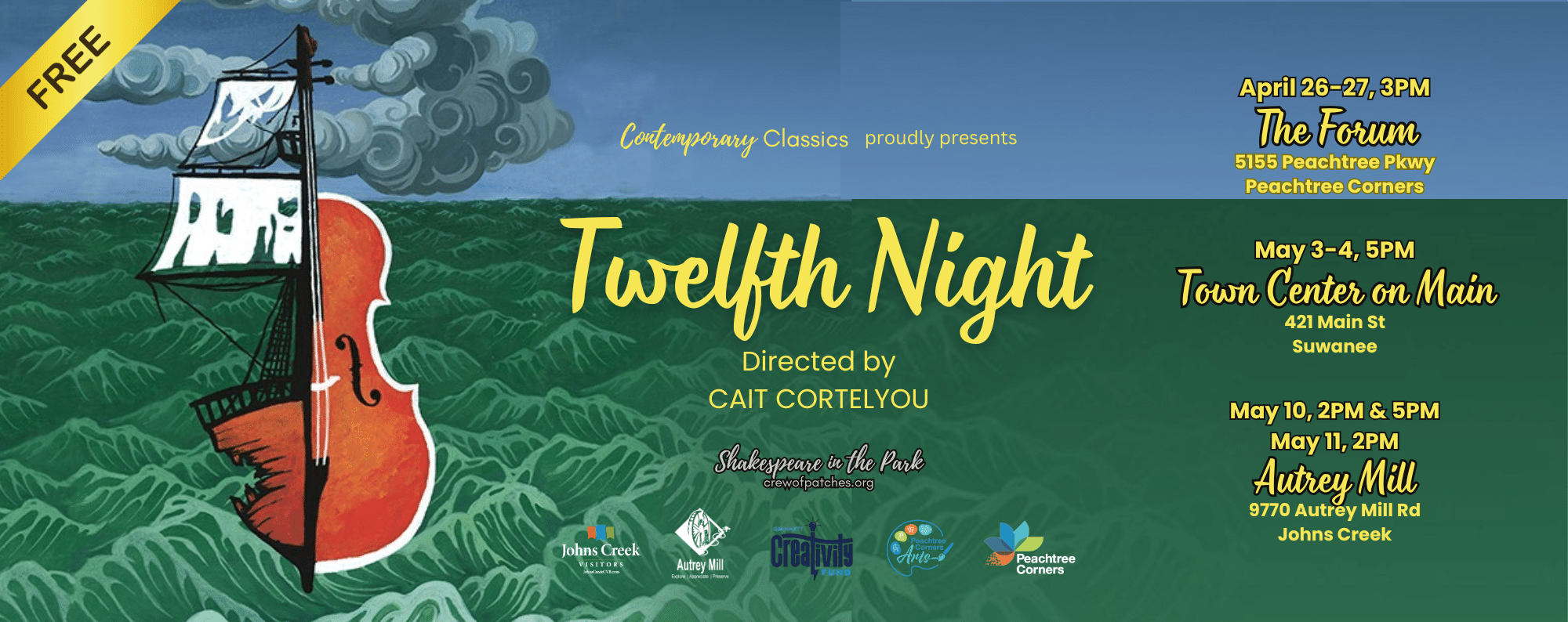
Contemporary Classics Theatre will present Twelfth Night, a free “Shakespeare in the Park” experience at three beautiful outdoor venues in north metro Atlanta
Twelfth Night, William Shakespeare’s romantic comedy of mistaken identity, will play at three beautiful outdoor venues in north metro Atlanta from April 26 to May 11.
Directed by Cait Cortelyou, known for her award-winning feature film “Ask for Jane,” Twelfth Night is a rollicking ensemble comedy explores unrequited love, misperceptions and the instability of gender.
Set in the coastal town of Illyria, young Viola survives a shipwreck and finds herself alone, believing that her twin brother died at sea. Disguising herself as a man, she finds work with the Duke Orsino, quickly falling in love with him. Orsino, however, is in love with the Countess Olivia… and Olivia quickly falls for Viola.
Meanwhile, Olivia’s steward Malvolia has bullied the household for the last time — and the staff is out for vengeance.
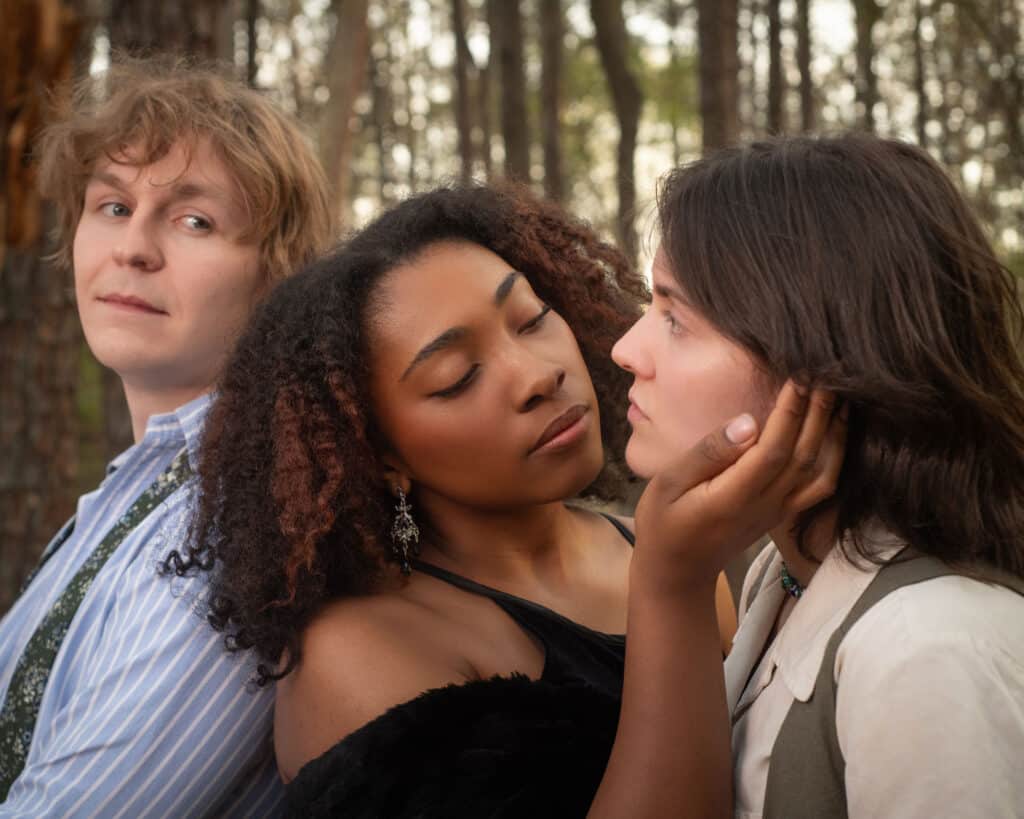
This timeless production of Twelfth Night features Allen Cox, Carl Fisk, Ryan Hutchins, Shem Louis, Susanna Lyne, Steven Medina, Matt Metzger, Danielle Montgomery, Macros Nora, TJ Sanson and Elliott Posadni as one of the first transgender actors to play Viola.
It also features costumes by artist Jordan Hermitt and production design by Sage Kim Gray.
Locations, dates and showtimes
The Plaza at The Forum Peachtree Corners • April 26–27 at 3 p.m.
Audience seating and a special musical performance will start at 2:30 p.m. Please note that seating is limited; arrive early and/or bring lawn chairs or blankets. Food and drink are available for purchase at the venue.
Town Center on Main, Suwanee • May 3– 4 at 5 p.m.
Audience seating and a special musical performance will start at 4:30 p.m. Please note that no seating is provided; bring lawn chairs and blankets. Coolers are welcome (no alcohol). Food trucks will be onsite at the venue.
Autrey Mill Nature Center, Johns Creek • May 10 at 2pm & 5 p.m.; May 11 at 2 p.m.
Audience seating and a special musical performance will start at 1:30 p.m. on both days and at 4:30 p.m. for the evening show on May 10. Limited bench seating only. In case of inclement weather, the show will move from the amphitheatre to the open-air Pole Barn nearby.
Admission to the shows is FREE. Register online for tickets.
About Contemporary Classics
Contemporary Classics exists to challenge and transform classic Western theater traditions by creating an inclusive community of diverse people, ideas and cultures. They believe that classic work is made even greater when performed by a larger variety of artists — especially those who have been marginalized by Wester theatre traditions — including women and people of color.
With no permanent home, the theatre company partners with places such as public parks for performance spaces. This “homeless” state is one of the reasons they call ourselves “a crew of patches”— they travel from “patch” to “patch” with their shows.
The name also comes from a line in A Midsummer Night’s Dream, and reflects the “motley” coat of a Shakespearean clown (or fool), created by sewing patches of old or discarded clothing together in a mishmash of textures and colors, like a patchwork quilt.
Fools, or “Patches,” transcend societal norms by being simultaneously a part of society and outside of it, giving them the ability to examine and comment on it.
For more information, visit crewofpatches.org.
Related
Arts & Literature
From Food Creations to Handmade Jewelry: Wesleyan Kids Prep for Artist Market 2025 [Podcast]
Published
1 month agoon
April 7, 2025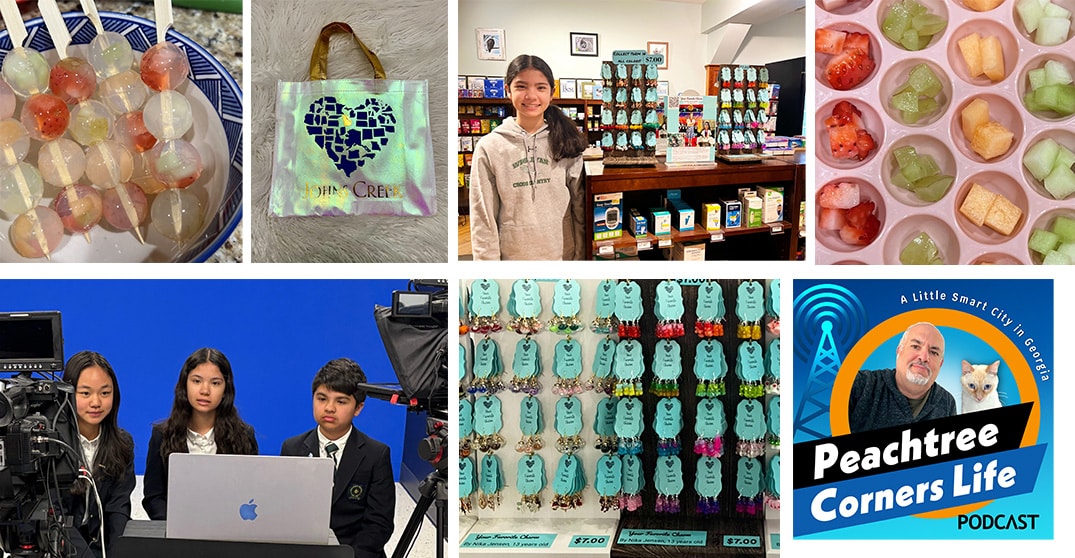
In this episode of Peachtree Corners Life, host Rico Figliolini spotlights three remarkable student artists featured in this year’s Wesleyan Artist Market. Eighth graders Kimberly Wang and Nika Jensen, along with sixth grader Carter Jensen, share their creative journeys—ranging from edible art like fruit jellies and peppermint bark to handmade jewelry and custom-designed bags.
Kimberly talks about her love for food art and balancing sweetness with fruity freshness, while Nika and Carter discuss building a jewelry business that also gives back—donating proceeds to families in the Philippines. This isn’t just an artist market; it’s a showcase of purpose-driven, globally inspired young talent. The event runs April 25–26 at Wesleyan School and is open to the public.
Podcast Takeaways:
- Kimberly Wang creates handmade edible treats, balancing flavor and freshness for the show.
- Nika and Carter Jensen co-run a jewelry and fashion accessory business, inspired by global travel and cultural experiences.
- Nika donates part of her proceeds to support families in the Philippines.
- All three students are deeply involved in extracurriculars—from musicals, marching band, math club, and academic bowl.
- The Wesleyan Artist Market features 24 student artists and over 70 professionals—open to the public April 25–26.









Timestamp:
00:02:19 – Student intros and extracurriculars
00:03:06 – First-time participants and motivations for joining
00:04:13 – Kimberly’s edible art and recipe testing process
00:05:16 – Nika and Carter’s jewelry and bag design business
00:07:06 – The reward of watching people enjoy your creations
00:08:20 – Donating art profits to support families in the Philippines
00:10:39 – Future aspirations in medicine and law, with art as a passion
00:12:06 – Behind-the-scenes logistics of preparing for the market
00:13:25 – Global travel inspiration: 73 countries and counting
00:17:19 – Where the students draw artistic inspiration
00:20:04 – Custom requests: From peppermint bark to Lego earrings
00:21:16 – Anticipation and excitement for this year’s market
00:22:29 – Reflections on Wesleyan and the artist experience
Transcript:
00:00:01 – Rico Figliolini
Hey, everyone. This is Rico Figliolini, host of Peachtree Corners Life. We have a great set of guests today. Because of the upcoming Wesleyan Artist Market, we thought we’d do some interviews with student artists. Three of the 24 that are going to be at Wesleyan Artist Market. So they’re with me here today. So we’re going to get right into that shortly. I just want to say thank you to our corporate sponsors. So I want to say thank you to EV Remodeling, Inc., based here in Peachtree Corners. The owner is Eli. Him and his family live here. They’re great. They do a lot of design work, design your space. Essentially, any home remodeling you need from whether it’s your kitchen, your bathroom, or a whole house remodel, or even an addition to your home, think about it, whatever you need, Eli can handle. So check them out. Go to evremodelinginc.com and find out how they can design your space and your life. Our next sponsor just came on, and they’re Vox Pop Uli. I want to thank them for joining us as well. They deal with all sorts of things you can imagine putting your logo on, similar to a little bit about what these kids do, right? They’re creating artwork. They’re creating a brand for themselves. And so this is what Vox Pop Uli does, right? They’ll take your brand and bring it to life. Essentially, anything that you can think of that would go on apparel, whether it’s sweaters or T-shirts or wherever you want to put your brand engraving, your logo, what object you want to put it on, even vehicle wraps. So if you’ve got a truck, you want to put a whole wrap around it, check them out because they can do that. They’re here in Peachtree Corners and they’re called Vox Pop Uli. So visit their website. I’ll have the links in the show notes as well. So thank you guys. I appreciate your support. So now let’s get right into it. Let me introduce our three artists, great Wesleyan students. Can’t wait to start talking to them. We have Kimberly Wang first on your left, on my left, and Nika and her brother Carter Jensen, who work together creating the artwork they do. So I’m going to ask you guys just to, you know, give me a little background. Tell me who you are, your grade, what you do, extracurricular, stuff like that. This way our audience can get to know a little bit more about you. So let’s start with Kimberly Wang. Hey, Kimberly.
00:02:19 – Kimberly Wang
My name is Kimberly Wang. I’m in eighth grade this year, and outside of Artist Market, I do marching band, and I also do the musical production this year, which is Matilda.
00:02:31 – Rico Figliolini
Excellent. What about Nika? How about you?
00:02:34 – Nika Jensen
I’m also in eighth grade. My name is Nika Jensen, and apart from doing the Artist Market, I do cross country. I’m also in Matilda this year, and I also do math counts, which is a math club.
00:02:47 – Rico Figliolini
Okay, cool. And Carter?
00:02:49 – Carter Jensen
Hello, my name is Carter Jensen. I’m in the sixth grade. And outside of the artist market, I do academic pool and I also do basketball.
00:03:00 – Rico Figliolini
Excellent. Alright, cool. So have you guys ever done the artist market before? Is this the first time?
00:03:06 – Kimberly Wang
This is my second year doing it this year.
00:03:08 – Rico Figliolini
Second?
00:03:10 – Nika Jensen
Yeah, this is our first year because we’re new students this year.
00:03:13 – Rico Figliolini
Alright, cool. What inspired you to get into it, Nika?
00:03:17 – Kimberly Wang
Well, I had my own business before we came to Wesleyan and so I thought that the artist market is a good way to like show my business to other people in our community. So yeah.
00:03:30 – Rico Figliolini
And you brought in your brother Carter to help you with?
00:03:35 – Nika Jensen
Yes, sir. He’s also part of the business.
00:03:39 – Rico Figliolini
Alright cool. Okay so, Kimberly. Food. Food is art, right? I’m sure your mom would probably say, it’s food, just eat it. But you’re playing with your food, essentially. What they used to tell you not to do, right? So when you create your food art, what do you think about? How do you go through this? How do you choose what you do and what do you exactly do?
00:04:13 – Kimberly Wang
So this year, I am making fruit jellies and peppermint bark. And when I think about what creations I want to make for the artist market, I go online and I look through like, what are some popular desserts that a lot of people like? And once I like choose my items, then I go through
the recipe and then I do a lot of trial and errors to make sure that like the products are like healthy and they taste well.
00:04:42 – Rico Figliolini
So they have to be edible, right? Because this is edible art?
00:04:45 – Kimberly Wang
Definitely, yes.
00:04:46 – Rico Figliolini
So are you eating a lot of the edible art before you get to what you need?
00:04:50 – Kimberly Wang
Not really. I don’t usually taste a lot of the food. I let my family taste it.
00:04:56 – Rico Figliolini
Ah, good. I like that. Yes. Get them to participate. Cool. So edible art, that’s one way of doing it. Jewelry, that’s something else, right? Wearable. How do you guys, Nika, Carter, how do you get to the place of what you do?
00:05:16 – Nika Jensen
So I started my business when I was 11 years old and it started like I got my first jewelry making kit and I kind of just expanded from there. So like I usually use Amazon to search and find like the prettiest designs like of earrings and pendants and get opinions from other people like my mom and my family to see like if they think it’s like wearable and if they like it. So I browse on Amazon for a while and I find like the best and high quality products and then I hand make them at home usually like every day after I come home from school so and my brother he does something else and he can tell you about that.
00:06:01 – Carter Jensen
I, my sister, she got a Cricut machine for, like, her 12th birthday, I think. And started making these, like, iron-on bags with the Cricut machine and, like, making them based on, like, Georgia and, like, Wesleyan and designing it based on fashion.
00:06:19 – Rico Figliolini
Alright. Cool. So let’s get back to Kimberly. The food that you do. Do you have particular flavors you like? Do you have particular areas that you stay in?
00:06:33 – Kimberly Wang
So this year I’m trying out like something more sweet with chocolate. But last year I definitely went for more of like the fruity side. And I think I like to keep it like a balance. So that way one is not overpowering the other. My personal favorite will probably be fruit because it’s healthy. And I mean, it just tastes good in general.
00:06:56 – Rico Figliolini
Okay. Alright cool. What’s the most rewarding part that you can think of, of making edible art?
00:07:06 – Kimberly Wang
Well, I mean definitely like you said before you get to eat a lot of food. I mean, I did say before that I don’t eat a lot of the creations I make, but sometimes I still do eat it. And so I think it’s also really rewarding to see like people try out your creations and see like their reactions to what they think of it.
00:07:27 – Rico Figliolini
So when, I know I’ve spoken to other artists when they sell their artwork like paintings or stuff like that they get a chance to see it sometimes when the fan that bought it if you will, would send them a picture of where they hung it right? Yours disappears right?
00:07:45 – Kimberly Wang
Yeah, exactly.
00:07:47 – Rico Figliolini
Yeah I guess, there’s no way to, short of doing a selfie with it or taking pictures of it, there’s no there’s no permanency to it so how does that feel?
00:07:57 – Kimberly Wang
I mean well as long as the people enjoy it that’s good. And I mean I think mainly it’s about like the memory that you have of having the food and if you like it then it stays as a good memory for you and if you don’t then I mean you can always try out different things.
00:08:20 – Rico Figliolini
Okay. Nika, Carter, as far as the jewelry goes the, you’ve used it to raise money to support children in the philippines? yes
00:08:29 – Nika Jensen
Yes sir.
00:08:31 – Rico Figliolini
Is that, is that how you started this when you were 11? Is that the reason?
00:08:35 – Kimberly Wang
No, so I was like 11 during the pandemic. So I was always looking for a way to express my creativity. And so that’s how I started my own business. And so I was selling at my uncle’s pharmacy and I was saving up the money to use for like college or for like other events later on in my life. But this last year and a half before this school year, we were living in the Philippines. And so I was really touched by all of the families there. And we even did something similar where we gave out food and canned goods over Christmas to poor families there. So that just
really touched me. And so ever since we got back to America, I’ve been donating part of my profits to other families in the Philippines.
00:09:24 – Rico Figliolini
Carter, did you end up going on that trip as well?
00:09:28 – Carter Jensen
Yeah, I was with her. We stayed there for about a year and a half. We also did schooling there.
00:09:36 – Rico Figliolini
It’s interesting brothers and sisters, I have three kids and you know growing up brothers and sisters always there could be dynamics there. So how do you get along? Do you ever say to your sister, I don’t know about that. You know that might not look as good, that might not sell. Do you give good feedback? I mean how do you praise her or how do you work together?
00:09:58 – Carter Jensen
She’s more of the leader of the business so like I usually just like try to like agree with her and like yeah.
00:10:12 – Rico Figliolini
Alright that’s cool well you need a leader of the pack sometimes right? So Nika the artwork that you do, you know this is part of what you do you’ve mentioned other things you do right? I know you’re young, you all are, you know you’re not old enough to really think well maybe you are to really think what you want to do with your life right? Is art something that you want to keep as part of what you’re doing in your life?
00:10:39 – Nika Jensen
It’s definitely something that’s of great value to me, but I kind of want to pursue the medical field, but art is also really important to me.
00:10:49 – Rico Figliolini
Okay. Sounds good. Same question to Kimberly. What about you? How do you feel about the work you do?
00:10:57 – Kimberly Wang
I definitely enjoy making food, but like Nika said, I was also really interested in the medical field. And so like I’m not really sure if I’m going to continue pursuing this. But I mean it’s definitely brought me a lot of joy while doing food art.
00:11:15 – Rico Figliolini
Okay. Medical field both of you, that’s cool. What about Carter? How about you? 00:11:19 – Carter Jensen
I kind of like, I like doing art it’s one way to like express your creativity as my sister said. But I also kind of, I’m not really sure what I want to do when I grow up, maybe be a lawyer.
00:11:33 – Rico Figliolini
Okay. Well, artwork gives you a chance, right, to play a little bit, to be able to also see how people, like Kimberly, like you said about how when people see your food or taste your food and your food art, if you will, and it gives you a chance to see how people appreciate what you’re doing, I think, right? The challenges of making food art and keeping it fresh and making sure you’re going to deliver it on the right way I guess at the Wesleyan artist market, how do you how do you handle that part of it?
00:12:06 – Kimberly Wang
So for me the night before each day of the selling I would stay up really late and I make all my products so they’re all fresh and they’re all new. Because I want the best for the people that are eating the food because I don’t want anything to go bad overnight and so I make sure that it’s always new products and I make it, yeah.
00:12:32 – Rico Figliolini
We don’t have the same issue with the jewelry that you do, Nika. So that could last forever, right? But putting it together, sourcing the supplies, right, of what you do, the logistics of it, I guess. How do you handle that? Like getting all the materials together? Do you order it all on Amazon?
00:12:52 – Nika Jensen
Yeah, I order like 99% of all of my things from Amazon. And then since I already have the materials shipped to me, then all I have to do is just create them from my house. So it’s easier for me than having to go out and buy supplies at stores.
00:13:11 – Rico Figliolini
Sounds good. What inspires you as far as jewelry goes? I know that you said you look online to see other things and what the trend is. So where do you find most of your trends? Is it just on Amazon or is it social media, other places?
00:13:25 – Nika Jensen
I kind of observe other people and like what they wear and also social media. And I get a lot of inspiration also from like nature and from like my travels. We’ve been to a lot of countries in the past five years, 173 countries.
00:13:44 – Rico Figliolini
How many?
00:13:45 – Nika Jensen
I’m sorry, not 173, 73 countries.
00:13:49 – Rico Figliolini
73 countries?
00:13:50 – Nika Jensen
Yes, sir.
00:13:51 – Rico Figliolini
That you’ve been to in how many years? I can’t even wrap my head around that. How did you even do that? Teleport? I mean, how did you do that? Wow. What is your heritage, if you don’t mind me asking?
00:14:12 – Nika Jensen
I’m half Filipino. My brother and I are half Filipino. And then my father is part Danish and then also American.
00:14:21 – Rico Figliolini
Do you speak any languages?
00:14:23 – Nika Jensen
I speak the language of the Philippines called Tagalog and then English. And I’m learning Spanish.
00:14:30 – Rico Figliolini
Really? Okay. Kimberly, how about you?
00:14:33 – Kimberly Wang
So my mom is Taiwanese and my dad is Chinese. So I speak Chinese, English. I’m learning French and I’m learning Korean.
00:14:43 – Rico Figliolini
Really? Wow. Okay. Speak Mandarin, is it? Okay. My son was learning that for a year and he was, it’s a tough language to learn. But I’m sure being able to travel for example Nika, to be able to see other other countries and inspiration from those countries. What of the 73, 75 countries you visited what would you say the top five would be for that type of inspiration? Can you pick that up?
00:15:16 – Nika Jensen
I think so. I really like Argentina just because it’s so unique and the culture is just so strong there. Like you really feel so immersed just when you like step into the country. I like Italy, not only because of the food, but that’s also where I got a lot of inspiration for my jewelry. Just like the glass in Venice, like the Murano glass, like that’s also a really big inspiration. In Turkey, that’s when I first like found my interest in jewelry because there was, we went to this bead store and there was like thousands of different beads and I got to like choose different charms and like experiment with creating jewelry. So Turkey, Argentina, Italy, and then I have to give it to the
Philippines, obviously, because we lived there for so long. And then that’s hard. What do you think, Carter?
00:16:12 – Carter Jensen
I like India because I really like butter chicken. Also like Italy because I like pizza and pasta.
00:16:27 – Rico Figliolini
Yes, can’t get any better pizza than Italy, that’s for sure.
00:16:30 – Carter Jensen
Yeah, it’s really good there. And I also like Japan because it’s very futuristic and it’s like…
00:16:38 – Rico Figliolini
Is it?
00:16:39 – Carter Jensen
Yeah, it’s like a new environment and it’s like…
00:16:45 – Rico Figliolini
Yeah, cool. I can’t wait I think where, I think we may be heading there in July so that would be fun. I’ve never been so that would be interesting. Cool so with the artwork, with the inspiration, with the journey that you guys have been on, do you think that, are there any artists it’s hard and food maybe unless it’s Gordon Ramsay or something, but do you draw any inspiration? Who do you draw inspiration from for the work for what you do? Let’s start with Kimberly.
00:17:19 – Kimberly Wang
I don’t really have a specific artist that I look up to but I do watch some cooking shows and some like dessert making shows and they always really inspire me so I feel like that’s what really led me into like starting food art. And so I was like, whoa, this is really cool. And so I was like, okay, let me try this. And so now I’m here and then I’m like, this is pretty fun.
00:17:49 – Rico Figliolini
Oh, okay. Carter, I know you’re not the main person doing the artwork, but what do you see when you’re working with your sister? How does that feel working with her, doing the stuff with her, the artwork? Whatever you’re doing with her, how you know what’s that journey feel like for a brother and his sister?
00:18:13 – Carter Jensen
It’s kind of relaxing doing artwork and like peeling off like the stickers on the bags
00:18:26 – Rico Figliolini
Okay, alright, that’s cool. Sister, how do you feel?
00:18:30 – Nika Jensen
Yeah I just enjoy anytime I’m like I get to make jewelry because I feel like it’s such like an important thing to me. And it also like my brother said it’s really relaxing and just like sitting in our home and just like making jewelry it’s like, it’s really fun for me.
00:18:48 – Rico Figliolini
Do you wear? I’m assuming you wear some of the stuff you make?
00:18:51 – Nika Jensen
No actually I don’t have my ears pierced. And so I just like making it and seeing my creations on other people.
00:19:00 – Rico Figliolini
Okay, cool. Kimberly, do you ever decide, I’ve got to make something, I want to eat something, do you ever decide to do that, or is it always just for the art?
00:19:10 – Kimberly Wang
I think mainly just for the art. Because, I mean, I do piano outside of school, and so most of my time is sucked into that. But, I mean, sometimes if I do want to make something, yeah, I’ll go for it. And I’ll try my best, but it might not be successful.
00:19:31 – Rico Figliolini
Have you ever been, have you ever designed anything custom design? Because someone requested it from you? Like has anyone ever asked Kimberly, has any anyone ever asked yeah can you make that for me? Like aside from the artwork you sell.
00:19:50 – Kimberly Wang
I don’t think so. I did get one request by a high schooler to make peppermint bark for him for his art and science class. But like other than that, no.
00:20:00 – Rico Figliolini
Okay. How about Nika? Have you ever had a request for jewelry?
00:20:04 – Nika Jensen
Yes, I have. So my mom was posting some of my creations on social media and someone reached out to me and she wanted lego earrings like so little like lego figurines as earrings. So I used some of my own legos and then we also bought some but I drilled a hole on top of their head and I had to stick a screw inside. I had to mail it to them. And then they sent me a picture of them wearing it.
00:20:42 – Rico Figliolini
It’s just the way you were describing it, drilling the hole in the head. It’s like, all right, well, that’s good. So there’s the art. You do anything for art, I guess. That’s good. Great. We’ve been showcasing and talking a lot about art here and food and stuff. What are you looking forward to this year’s Wesleyan Artist Market? What is it that’s looking forward? I mean, you have there’s
three of you out of 24 other students. Have you seen or talked to other students and what they’re doing for the show, for the market? What are you looking forward to?
00:21:16 – Nika Jensen
To me?
00:21:17 – Rico Figliolini
Yeah, sure. Let’s go with it.
00:21:18 – Nika Jensen
Okay. Yes. Kimberly and I are actually really good friends so we’ve been like talking with our other friends that are doing the artist market and we’re like you know what they’re selling and yeah. I’m just really excited because we’ve never my brother and I have never done something like this before so I think it’ll be a really good opportunity and it’ll be fun so.
00:21:39 – Rico Figliolini
Something wholly new. That’s good, a good experience. How about you Kimberly?
00:21:45 – Kimberly Wang
Ever since last year, I was really astonished by everything I saw, even if it was like the adult artists, but like the student artists, they were all so talented. I know like a few other people are making food art and people like Nika are making jewelry. And so I’m honestly really inspired and just really blown away by all the effort that everyone puts in.
00:22:13 – Rico Figliolini
Cool. Anything that I’ve not touched on, guys, that you want to share about, individually about what it takes to do what you’re doing or your experience at Wesleyan? Why don’t we start with Kimberly?
00:22:29 – Kimberly Wang
I don’t really have much. I feel like this was a really nice opportunity to be able to share what Wesleyan Artist Market is about and how students have been able to participate in it.
00:22:42 – Rico Figliolini
Cool. Nika?
00:22:43 – Nika Jensen
Yeah so my mom printed out pictures of our time in the philippines so this first one it’s all the bags of food that my old school donated to families in the philippines.
00:23:01 – Rico Figliolini
Excellent. Glad you printed those out.
00:23:03 – Nika Jensen
This is my old class. This was this year when I sent my profits back to the Philippines. And those are all the boxes of food and clothes that they get with that money.
00:23:16 – Rico Figliolini
Wow, you really did make a lot of money.
00:23:18 – Nika Jensen
Yes, sir.
00:23:19 – Rico Figliolini
That’s good. That’s great. And maybe at some point I’ll ask Camille on this, getting some pictures from you all of some of the artwork that you’ve done. I’d love to include that when we post the podcast as well. And if you have any social media where you post your artwork on, if it’s public, feel free. We’re going to be sharing this and we’ll be taking you all as well. I think we got everything covered. I mean, you’re all just unbelievable kids. You’re just doing great work. And I’m just like, it’s always great to talk to you, to Wesleyan students, just like, or to students that are motivated, put it that way, to do things. So glad to see that you’re doing all sorts of things and I still can’t wrap my head around 75 countries, I’m just still trying to think that just like in five years, I can’t even see doing that. But I want to thank you all for for joining me so this is Wesleyan Artist Market you all will be at and that’s April Friday the 25th from 10:00 – 7:00 pm and Saturday April 26 from 10:00 to 3:00 pm. We’ve been talking with Kimberly Wang, who does food art, edible food art, and Nika and her brother Carter Jensen, who do jewelry. Appreciate you guys being with me and being so talkative and just being good guests. So thank you all. Hang in there with me for a second. Everyone else, I want to say thank you again for joining us. You can find out more about Wesleyan Artist Market from just going to wesleyanschool.org or just Googling Wesleyan Artist Market it’ll pop up for you. And it’s open to the public, Friday and Saturday in April. So check them out. Visit the 24 students that are displaying their artwork as well, along with the over, I think it’s over 70 professional artists there. And thank you all from, I guess you’re in Wesleyan Wolf TV station too. So appreciate you doing that with me. So thank you everyone. Stay well.
Related
Arts & Literature
Perimeter Ballet Celebrates 30 Years of Dance and Inspiration
Published
2 months agoon
March 14, 2025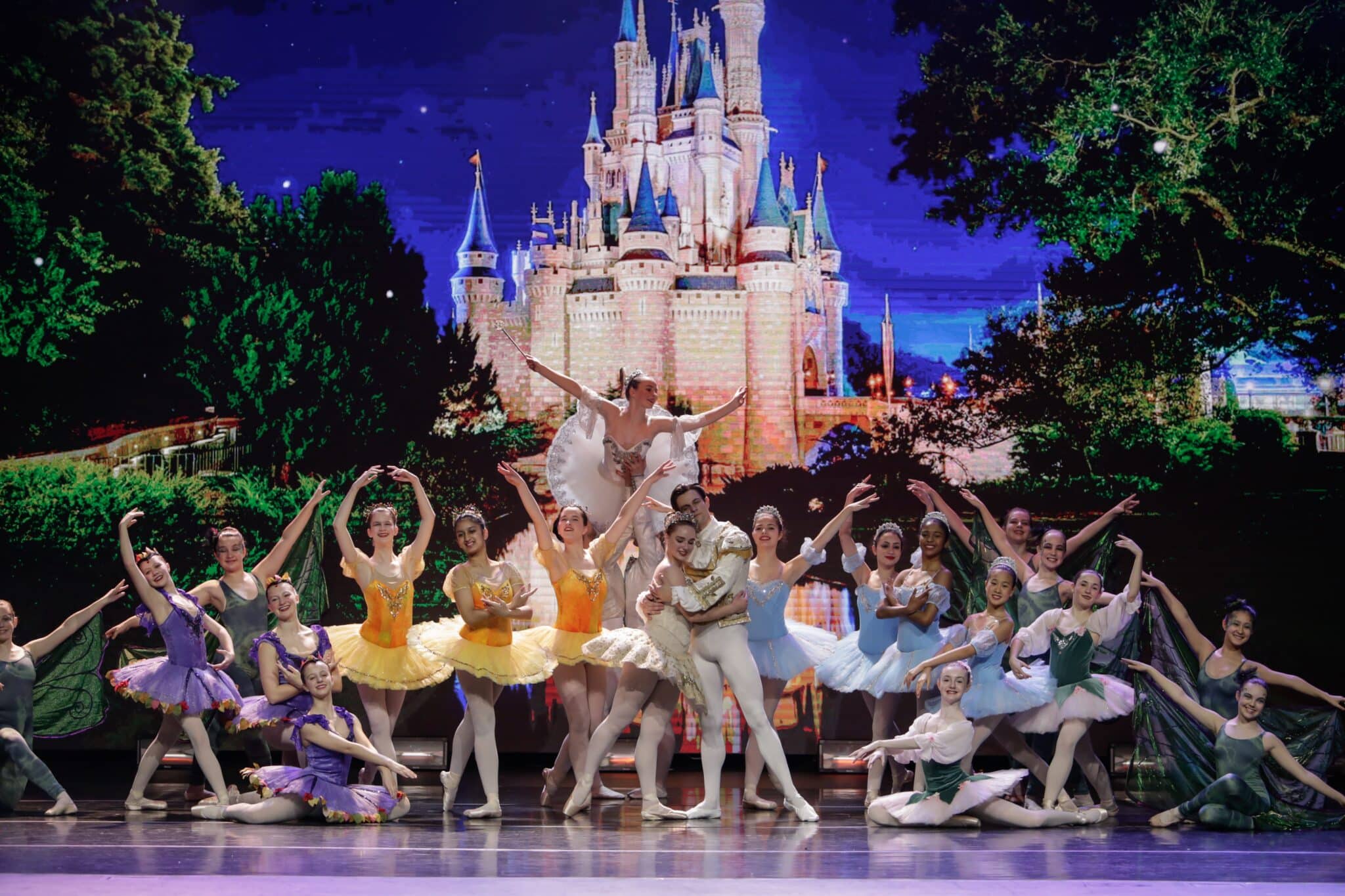
Perimeter Ballet celebrates its 30th anniversary this year. Founded in September 1995, the faith-based ballet school in Johns Creek has long been an integral part of the local arts scene and the community.
What began as a bare-bones program held in the sanctuary of Perimeter Church — on carpeted concrete floors, using the backs of chairs for barres — has grown into a respected school of more than 200 students. Ranging in age from five to 18, the young dancers at Perimeter Ballet are not only committed to the study of dance but also to using their gifts to share their faith.
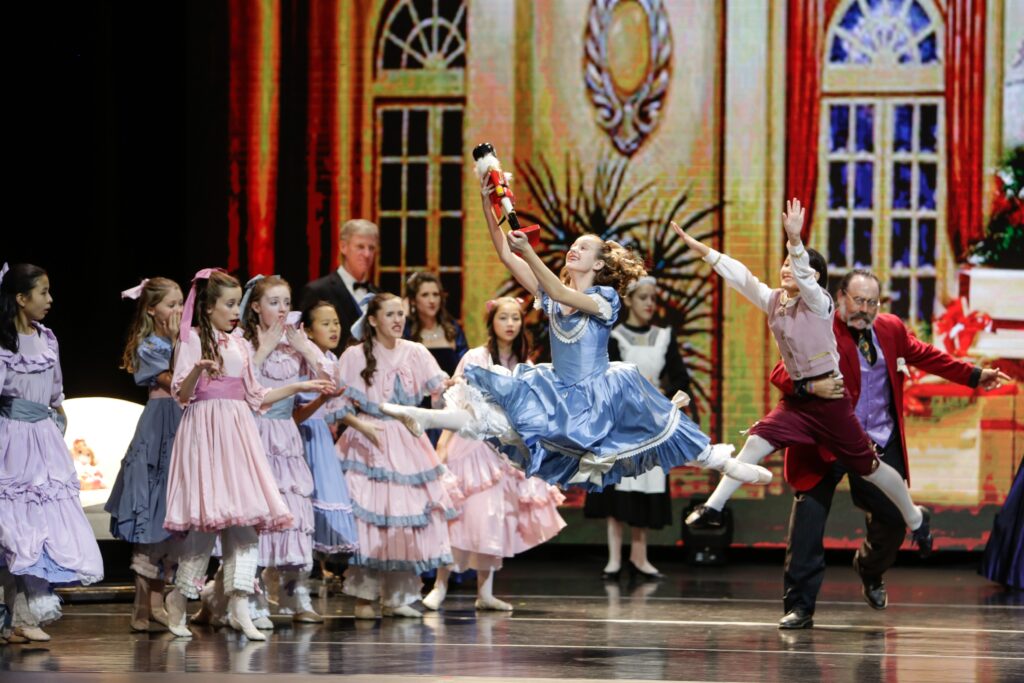
According to the program’s website, their purpose is to “emphasize character along with technique … to counter the natural tendency towards self-absorption in the ballet studio.”
They are “very committed to teaching children to dance — to develop discipline, technique and musicality. [But] the Christian instructors [also] train the students in a context that understands that there’s a reason to dance.”
30 years of dance and faith
Current director, Becky Brown, has led the school for several years, growing the program while faithfully following Perimeter Ballet’s original mission. She oversees weekly classes, summer dance camps and annual productions, including an acclaimed Spring Recital and a presentation of The Nutcracker each December.
For the 30th anniversary, Brown is excited to continue the creative work of the ballet school and share their artistry and message with a larger audience.
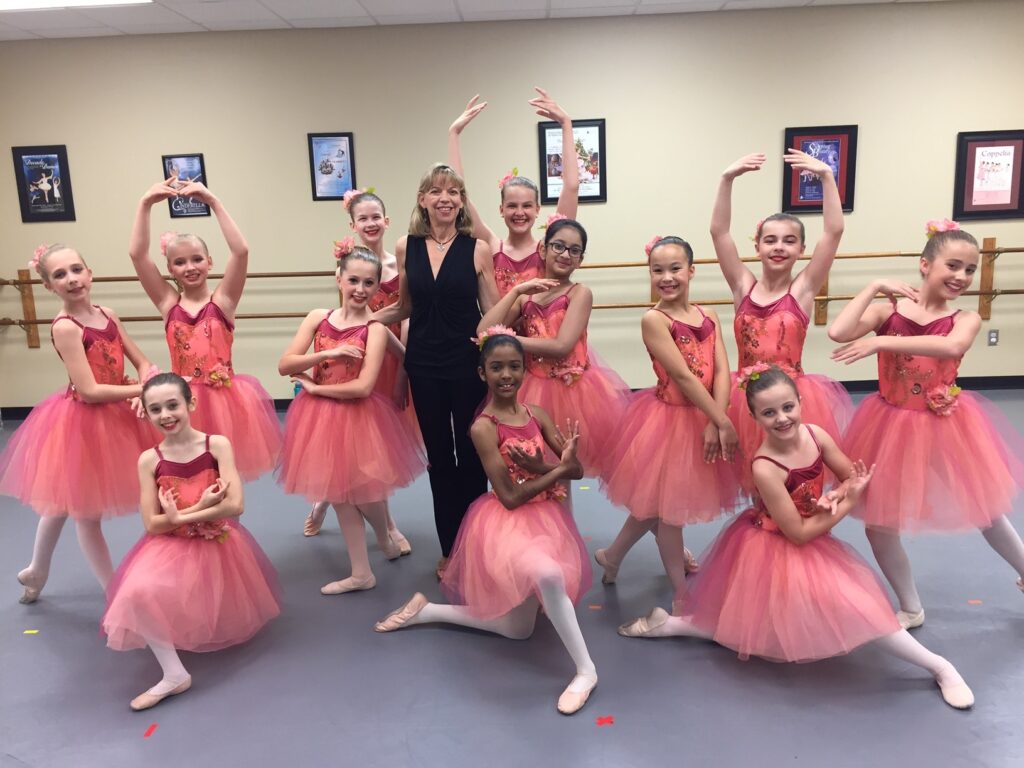
“This year will certainly be a special time for us as we celebrate and look back on 30 wonderful years of Perimeter Ballet and 20 years for our performing company, For His Glory,” she said. “We will be performing the Nutcracker December 11–13 and will have some beautiful new costumes to commemorate the occasion. We look forward to seeing many of our alumni and their families at the performance.”
Classes and instructors
Open to the community at large, weekly classes at Perimeter Ballet range from Creative Movement, PreBallet and grade-level classes for preschoolers through third grade to more advanced classes (two or more times per week) for older students.
Summer camp sessions as well as intermediate level and advanced level intensives are also offered. For the upper-level intensives, students work on their ballet technique but also branch out into jazz and other forms of dance.
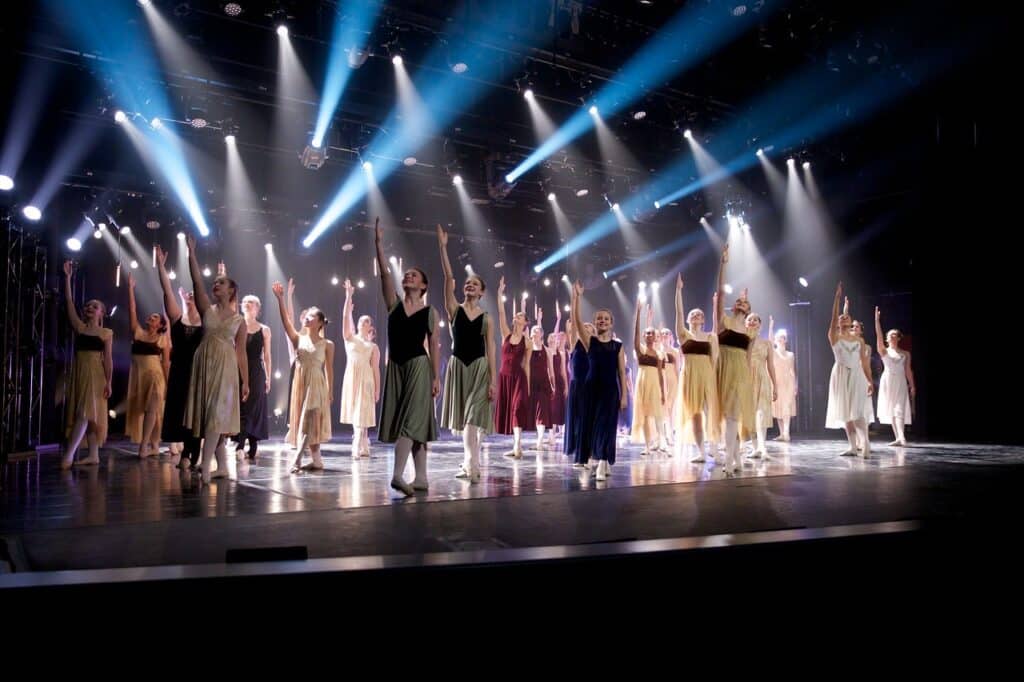
The school’s nine teachers are skilled not just as instructors but as performers themselves, having years of experience dancing with companies such as Ballet Southeast, Atlanta Ballet, North Atlanta Dance Academy and the Metropolitan Opera Ballet. They bring that experience and their Christian faith to all of their classes and interactions with the young students.
For His Glory
In addition to the work they do as a ballet school, Perimeter Ballet also has an audition-selected performance company — For His Glory.
With three levels, made up of dedicated students striving to advance their skills and reach their “God-given potential while giving glory to [their] Lord and Savior, Jesus Christ,” the program presents several high-quality productions throughout the year.
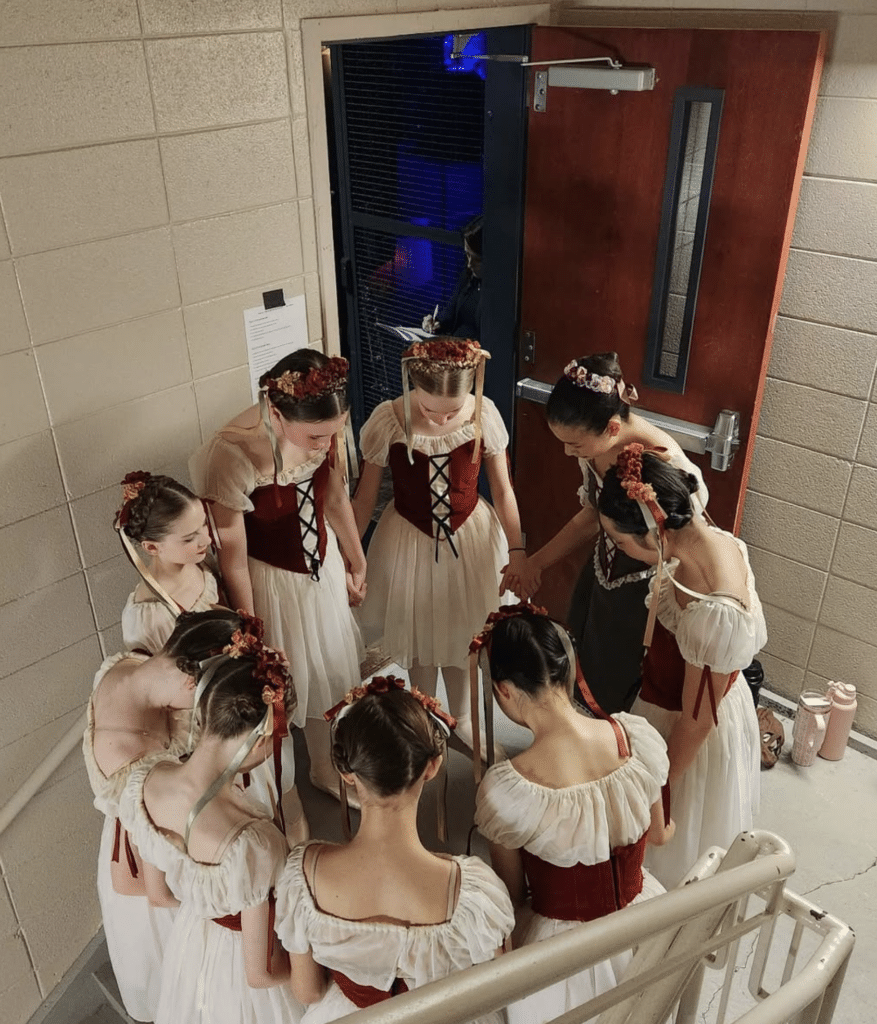
As Perimeter Ballet shares on their website: “Dancers are trained in the ballet classics as well as contemporary forms of dance, which are used in performances, worship settings and outreach. Classical ballets … in the group’s repertoire include Cinderella, Sleeping Beauty, Coppélia, excerpts from Four Seasons and La Fille Mal Gardee. In addition to Christmas and other outreach programs, For His Glory has danced internationally in London, India and Belarus.”
The group most recently performed Beauty & the Beast for two successful shows on stage at the Perimeter Church Sanctuary in early February of this year.
Impact and inspiration
All of this — the focus on faith and commitment to dance, the classes, intensives and stunning productions — have been a decades-long inspiration to the community and especially the student dancers who take part.
Many of the students stay with Perimeter Ballet for much of their childhood, learning and growing in dance as well as in their faith from elementary age through high school. That kind of involvement can clearly impact every aspect of their lives, from discipline learned to how they choose to interact with and be in the world.
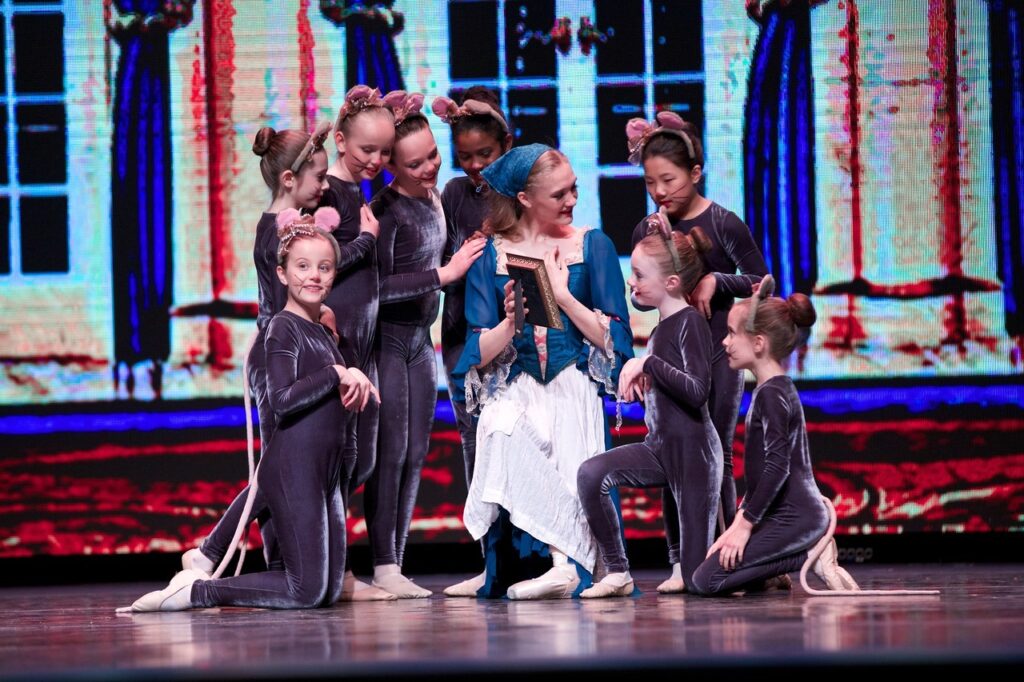
One student, Anne Bradley Maxwell has been taking ballet with the Perimeter program since she was three years old. Now a high school junior in Peachtree Corners, she’s reflected on her time at the school and in the performance company as well as Perimeter Ballet’s milestone anniversary.
“For fifteen years … I matured within this unique, local community arts program,” she shared. “This year marks the 30th anniversary of its founding … and I’m honored to say I’ve been a student for half of that era. The talented instructors in [the] program not only helped advance me into an accomplished ballerina but also into a more faithful servant of Jesus Christ using dance as a form of worship.”
A lifelong journey
“This lifelong journey included annual seasonal training, auditions, numerous external summer intensives and wonderful performances on stages across the nation and abroad, for audiences ranging from a few dozen to several thousand,” Maxwell continued.
“… Taking ballet has instilled in me a deep understanding of perseverance and resilience. Pursuing excellence in ballet required me to overcome physical and emotional challenges … I learned to seek out solutions — whether physical therapy for healing my body or prayer and reflection to rejuvenate my spirit. These experiences have strengthened my ability to face setbacks, adapt and emerge stronger.
Ballet has cultivated in me a unique combination of athleticism, discipline and creative imagination. The most elegant performances emerge from the interplay of technical mastery and creative expression. The collaborative nature of ballet, where individuals work in harmony to create something greater than themselves, informs my approach to teamwork and innovation, both in the classroom and community.”
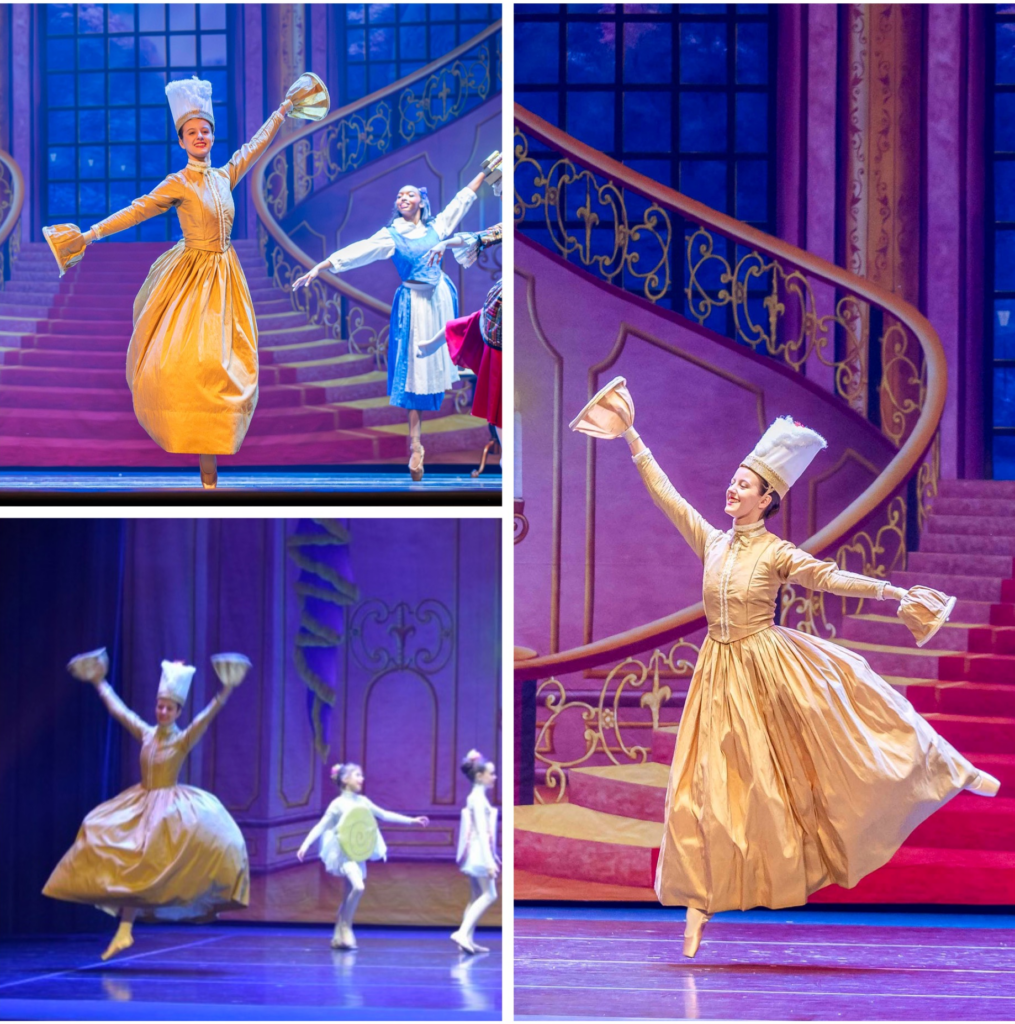
“… Ballet has [also] given me the gift of joy — both in experiencing it personally as a testament to Christ’s goodness and in sharing it with audiences. This joy, while intangible, is a powerful force that I hope to bring into my next chapters following high school. Whether through teaching movement, choreographing performances or exploring ways to expand ballet offerings, I aspire to enrich the community with the beauty and joy of dance.
… My time at Perimeter Ballet has equipped me with perseverance, discipline, creativity and a passion for sharing joy — qualities that I am excited to further cultivate as a young adult. These will not only enhance my personal journey but also contribute meaningfully to the rich tapestry of life. As I enter my senior year later this fall, I am full of gratitude for the solid foundation of technique and creative expression honoring God as the giver of my talent.”
Upcoming events
Perimeter Ballet’s Annual Spring Recital will be held in the Perimeter Church Sanctuary on Thursday, May 1 and Friday, May 2 from 7 p.m. to 8:15 p.m.
Summer camp sessions are scheduled for June and July. Registration will open on April 15.
2025-2026 classes will start in August with registration opening on April 15.
With help from Anne Bradley, the school is also planning a fundraiser event later in the year to mark the 30th anniversary.
For more information, visit perimeterballet.com.
Related
Read the Digital Edition
Subscribe
Keep Up With Peachtree Corners News
Join our mailing list to receive the latest news and updates from our team.
You have Successfully Subscribed!

GA Tech Launches First-of-its-Kind GT Atrium in Peachtree Corners

Katherine Lafourcade — A Journey of Passion, Resilience and Giving Back

Digital Edition

PCBA Announces 2025 Scholarship Winner

Paul Duke STEM High School Student Earns CGO Scholarship

World Blood Donor Day Starts Here: Theo’s Miracle, Katherine’s Mission [Podcast]

Executive Function: A Tribute to Working Moms

Peachtree Corners Grows Business Opportunities Through Economic Development

Simpson Elementary Marks Exceptional Children’s Week

Executive Function: A Tribute to Working Moms

Official City Merchandise Line Debuts This Saturday at Town Green

Peachtree Corners Grows Business Opportunities Through Economic Development

Digital Edition

World Blood Donor Day Starts Here: Theo’s Miracle, Katherine’s Mission [Podcast]

Paul Duke STEM High School Student Earns CGO Scholarship

PCBA Announces 2025 Scholarship Winner

Light up the Corners [Video]

Capitalist Sage: Business Leadership in Your Community [Podcast]

Cliff Bramble: A Culinary Adventure through Italy

Top 10 Brunch Places in Gwinnett County

A Hunger for Hospitality

THE CORNERS EPISODE 3 – BLAXICAN PART 1

Top 10 Indoor Things To Do This Winter

The ED Hour: What it takes to Remove Barriers from Education
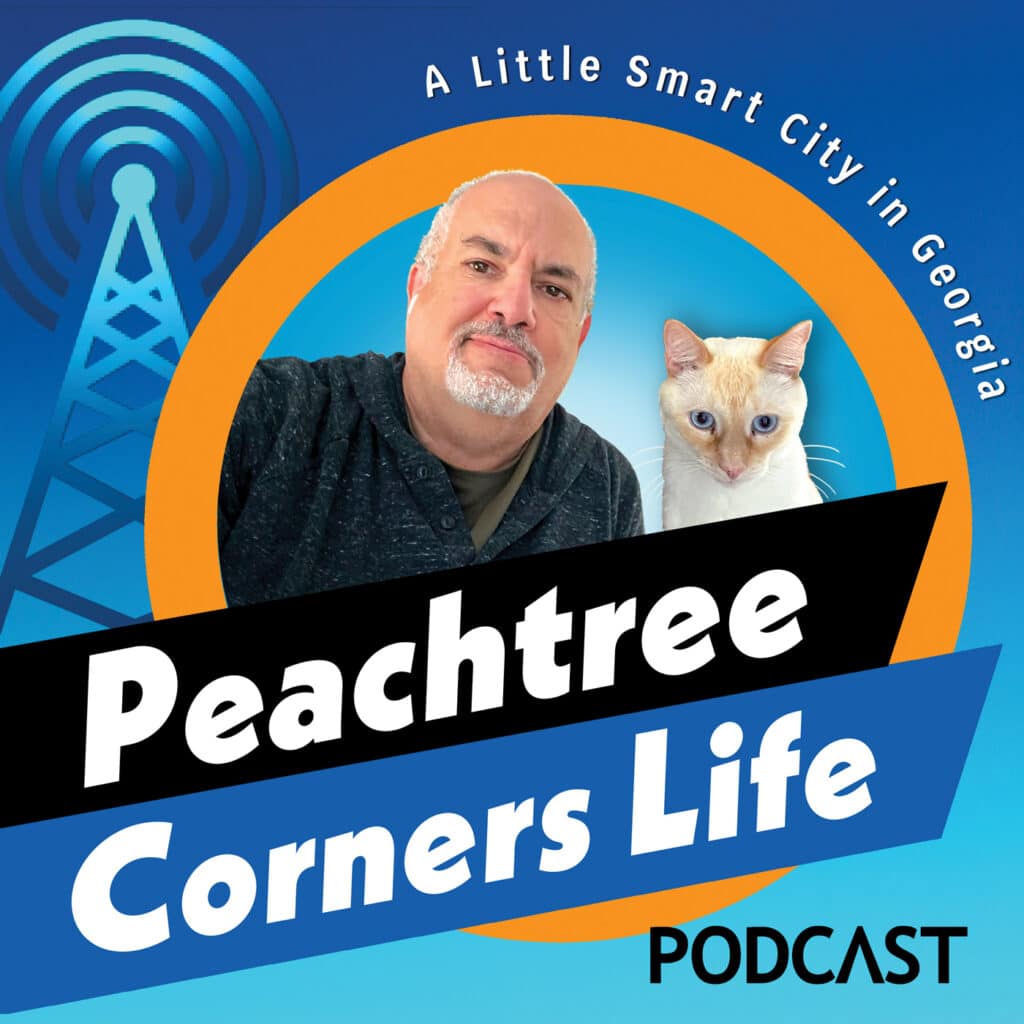
Peachtree Corners Life
Topics and Categories
Trending
-
Digital Edition4 days ago
Digital Edition
-
Podcast4 days ago
World Blood Donor Day Starts Here: Theo’s Miracle, Katherine’s Mission [Podcast]
-
Community2 days ago
Executive Function: A Tribute to Working Moms
-
Business3 days ago
Peachtree Corners Grows Business Opportunities Through Economic Development




